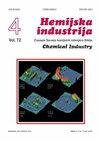等离子喷涂羟基磷灰石涂层的切割开裂及其与涂层结构特征的关系
IF 0.8
4区 工程技术
Q4 ENGINEERING, CHEMICAL
引用次数: 0
摘要
本研究估计了等离子喷涂羟基磷灰石涂层(HACs)在垂直于涂层/基底界面的方向上经受严重切割条件后的开裂现象。为了评估衬底预热对微裂纹发生的影响,在不同的初始衬底温度(TSS=20、100和200°C)下沉积了HACs。观察了相组成和HA飞溅形态随TS的变化,并与裂纹的发生有关。结果表明,恶劣的切削条件在HACs区域引入了局部裂纹,主要归因于脆性缺氢无定形磷酸钙(ACP)相。这种效应在没有预热衬底的情况下沉积的HACs中特别明显。另一方面,衬底的预热减少了微裂纹的存在,并导致平均局部相组成的微小变化。在衬底预热沉积的HACs中,HA飞溅物(由HACs组成)更薄,再结晶的HA区域尺寸更小,分布更均匀。这些结果表明,HA飞溅形成机制对等离子体喷涂的HACs中ACP和再结晶HA区域的分布以及HACs的抗裂性起着至关重要的作用。本文章由计算机程序翻译,如有差异,请以英文原文为准。
Cracking caused by cutting of plasma-sprayed hydroxyapatite coatings and its relation to the structural features of coatings deposited at different initial substrate temperatures
The present study estimated the cracking phenomenon in as-plasma-sprayed hydroxylapatite coatings (HACs) after they were being subjected to the severe cutting conditions in the direction perpendicular to the coating/substrate interface. In order to evaluate the effects of substrate preheating on the occurrence of micro-cracks, the HACs were deposited at different initial substrate temperatures ( T S = 20, 100 and 200 °C). The changes in phase composition and HA splat morphology with T S were observed and were correlated with the cracking occurrence. The results showed that severe cutting conditions introduced a localized cracking in the regions of HACs dominantly attributed to the brittle hydroxyl-deficient amorphous calcium phosphate (ACP) phase. This effect was particularly observable in the HACs deposited without preheating of substrate. On the other hand, the preheating of substrate reduced the presence of micro-cracks and caused insignificant changes in the average local phase composition. In HACs deposited with preheating of substrate, the HA splats (of which HACs are composed) were thinner and recrystallized HA regions seemed smaller in size and more evenly distributed. These results implied potentially important roles of the HA splat formation mechanism on the distribution of ACP and recrystallized HA regions in the as-plasma-sprayed HACs and the cracking resistance of HACs.
求助全文
通过发布文献求助,成功后即可免费获取论文全文。
去求助
来源期刊

Hemijska Industrija
工程技术-工程:化工
CiteScore
1.60
自引率
11.10%
发文量
12
审稿时长
6-12 weeks
期刊介绍:
The Journal Hemijska industrija (abbreviation Hem. Ind.) is publishing papers in the field of Chemical Engineering (Transport phenomena; Process Modeling, Simulation and Optimization; Thermodynamics; Separation Processes; Reactor Engineering; Electrochemical Engineering; Petrochemical Engineering), Biochemical Engineering (Bioreactors; Protein Engineering; Kinetics of Bioprocesses), Engineering of Materials (Polymers; Metal materials; Non-metal materials; Biomaterials), Environmental Engineeringand Applied Chemistry. The journal is published bimonthly by the Association of Chemical Engineers of Serbia (a member of EFCE - European Federation of Chemical Engineering). In addition to professional articles of importance to industry, scientific research papers are published, not only from our country but from all over the world. It also contains topics such as business news, science and technology news, information on new apparatus and equipment, and articles on environmental protection.
 求助内容:
求助内容: 应助结果提醒方式:
应助结果提醒方式:


